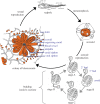Evolution of normal and neoplastic tissue stem cells: progress after Robert Hooke
- PMID: 26416675
- PMCID: PMC4633993
- DOI: 10.1098/rstb.2014.0364
Evolution of normal and neoplastic tissue stem cells: progress after Robert Hooke
Abstract
The appearance of stem cells coincides with the transition from single-celled organisms to metazoans. Stem cells are capable of self-renewal as well as differentiation. Each tissue is maintained by self-renewing tissue-specific stem cells. The accumulation of mutations that lead to preleukaemia are in the blood-forming stem cell, while the transition to leukaemia stem cells occurs in the clone at a progenitor stage. All leukaemia and cancer cells escape being removed by scavenger macrophages by expressing the 'don't eat me' signal CD47. Blocking antibodies to CD47 are therapeutics for all cancers, and are currently being tested in clinical trials in the US and UK.
Keywords: cancer; competition; leukaemia; neoplasm; stem cell.
© 2015 The Author(s).
Figures




References
Publication types
MeSH terms
Substances
Grants and funding
LinkOut - more resources
Full Text Sources
Other Literature Sources
Medical
Research Materials

